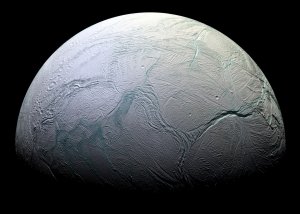
Ocean World
Back in 2015, it was found out that Saturn’s moon Enceladus is actually an ocean world with a subsurface ocean beneath an ice shell. However, no one could come up with a model that could reconcile the different data gathered about Enceladus, especially those gathered by the probe Cassini. That is, until now.
An international team of researchers have proposed a new model that explains the seemingly disparate data sets gathered from Enceladus, and hypothesizes that it has a much thinner shell than previously thought. Initial interpretations of data from Cassini flybys of Enceladus estimated that the thickness of its ice shell ranged from 30 to 40 km at the south pole to 60 km at the equator. However, an oscillation in Enceladus’s rotation (called a libration), linked to tidal effects, reduced the hypothesized thickness to around 20 km.
Published in Geophysical Research Letters, the study provides the internal structure of the moon: a rocky core with a radius of 185 km, then an internal ocean approximately 45 km deep, finally an ice shell with a mean thickness of around 20 km, except at the south pole where it is thought to be less than 5 km thick.
Greater Possibilities

The new model proposes an Enceladus that could better support life. The thinner ice shell means that the moon can retain less heat. Therefore, heat readings that were previously explained by tidal forces from Saturn need another explanation. Thus, the new model reinforces the idea of strong heat production in Enceladus’s deep interior that may power the hydrothermal vents on the ocean floor. The detection of complex organic molecules of unknown composition makes the possibility of life on the Saturnian moon more likely.
A far thinner shell could allow a future space exploration mission to gather data, particularly using radar, which would be far more reliable and easy to obtain than with a 40 km thick ice shell as initially calculated.